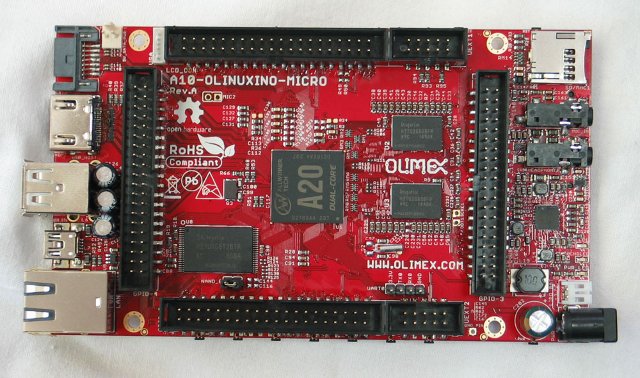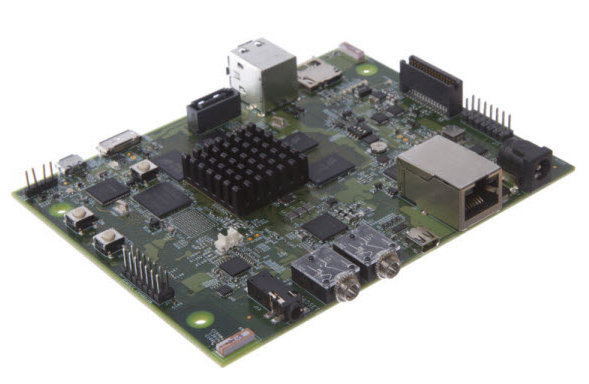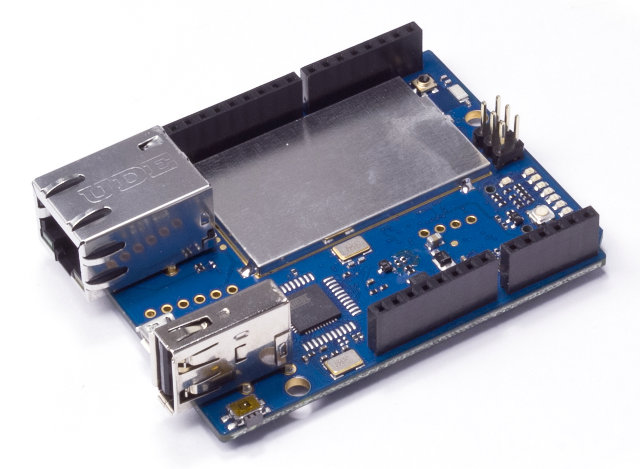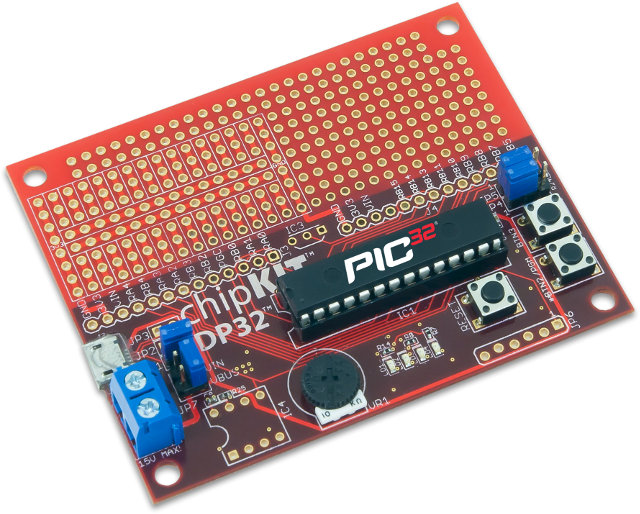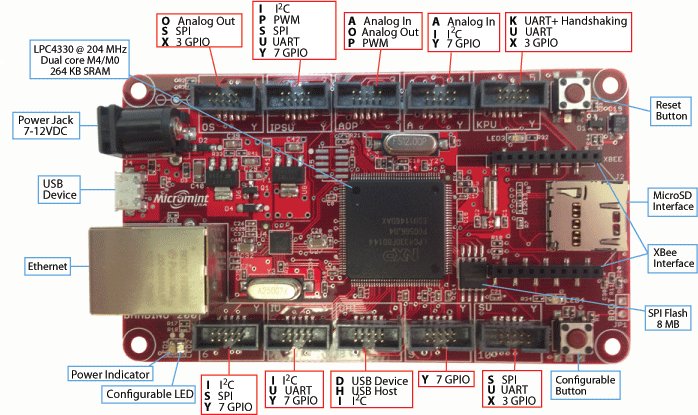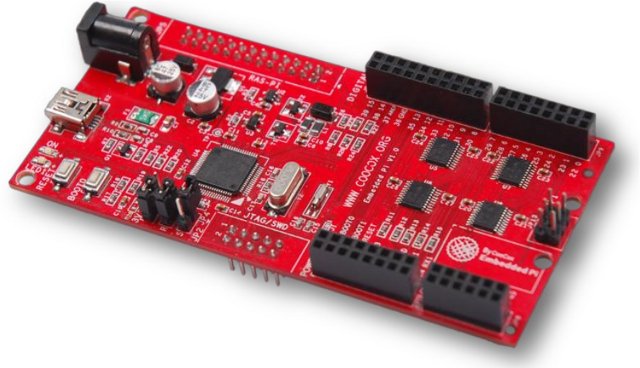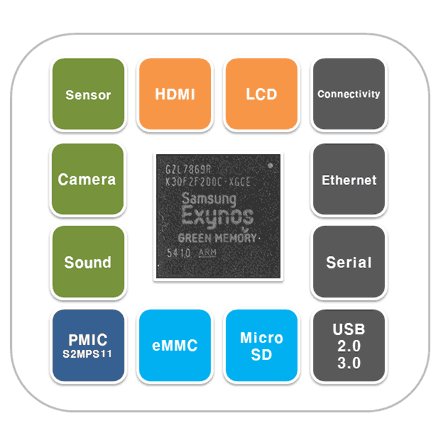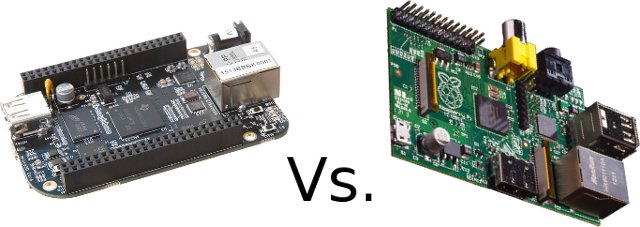Yesterday, Olimex showed their new A20-OLinuXino board. This AllWinner A20 board is still a prototype, and there are currently 3 of them only, but the good news is that it appears to be working, 50 developer edition boards will be manufactured shortly, and mass production should start in June. AllWinner A20 dual core Cortex A7 can clearly be seen in the middle of the board, but if you look close to the top left, you’ll see a marking: “A10-OLINUXINO-MICRO”. That’s because, as planned, they managed to design one PCB for both AllWinner A10 and A20 processors, and they’ll sell both versions. Olimex A10/A20-Olinuxino boards have the followings specifications: SoC – AllWinner A10 Cortex A8 processor or AllWinner A20 dual core Cortex A7 processor, both running @1Ghz System Memory – 512MB or 1GB DDR3 memory depending on model Storage – 4GB NAND Flash (optional), 2x microSD card slot, and SATA connector […]
$329 Texas Instruments OMAP5432 EVM / Development Board
Earlier this month, Texas Instruments has apparently discreetly, not to say surreptitiously, launched their OMAP5432 evaluation module. Beside the dual Cortex A15, dual Cortex M4 OMAP5 SoC, the board comes with 2GB RAM, a 4GB eMMC module, USB 3.0, SATA and more. OMAP5432 EVM Specifications: SoC – Texas Instruments OMAP5432 Multicore ARM Cortex A15/M4 processor with PowerVR SGX544MP2 GPU System Memory – 2GB DDR3L (implemented using 4x Micron 4Gb DDR3L devices (MT41K256M16HA-125:E) Storage – 4GB EMMC/iNAND Ultra device + SD/MMC 4-bit Micro-SD card cage Display / Video: HDMI via native OMAP HDMI interface DSI Display Expansion (DSIPORTA and DSIPORTC) via 100-pin expansion connector Parallel Display Expansion (DPI) via 100-pin expansion connector Audio – Audio Jack 3.5mm, Stereo out & in, Headset Jack (earphone/microphone) USB – 3x USB HS 2.0 (2 via USB connector, one via 0.1″ header), 1x USB 3.0, and 1x USB OTG 2.0/3.0 Connectivity – 10/100 802.3u Ethernet. […]
$69 Linux Powered Arduino Yún Board is Designed for the Cloud
Massimo Banzi announced the Arduino Yún, the first of a family of Wi-Fi products combining Arduino with Linux, at the Maker Faire Bay Area. The company used the name Yún (云), meaning “cloud” in Chinese, as the purpose of this board to allow connection to web services directly from Arduino. Arduino Yun Specifications: MCU – Atmel ATMega32u4 @ 16 MHz (same as the one used in Leonardo board) with 2.5KB SRAM and 32KB flash SoC – Atheros AR9331 MIPS-based Wi-Fi SoC running Linino, Arduino’s own Linux distribution based on OpenWRT. It’s the same chipset as in TP-Link WR703N router. Storage – microSD card slot USB – micro USB connector + full USB host port Connectivity – Ethernet + Wi-Fi 14 digital input/output pins (of which 7 can be used as PWM outputs and 12 as analog inputs) Arduino Yún ATMega32u4 can be programmed as a standard Arduino board by plugging it […]
Microchip Unveils 2 Arduino Compatible Boards, and a Prototype-Friendly PIC32 MCU
Microchip Technology has announced several new tools, expanding its Arduino compatible chipKIT platform ecosystem, based on Microchip’s 32-bit PIC32 microcontrollers (MCUs) available in low pin count SOIC or SPDIP packages. Digilent’s chipKIT DP32 board features basic I/O and interface components, including a prototyping aera, user buttons, and a potentiometer. The board (part # TDGL019) costs $23.9, and should be available on May 17 at microchipDIRECT. The chipKIT Fubarino Mini board, from a partnership between FUBAR Labs and Schmalz Haus, provides another option for Arduino-compatible development with 32-bit PIC32 MCUs, using a smaller form factor. The board is supposed to be available today for $19.95 on microchipDIRECT, but I could not find it yet. If you don’t want/need a development board, the company also provides PIC32MX250F128B MCU in PDIP package (28-pin) preprogrammed with chipKIT USB Bootloader. This MCU, clocked up to 40Mhz, includes 128 KB Flash and 32 KB RAM, as well […]
Micromint Bambino 200 and 200E Dual ARM Cortex M SBC Support .NET Gadgeteer and mbed Applications
Micromint, a US based supplier of single-board computers and industrial embedded controllers, has just announced Micromint Bambino 200 and 200E single board computers powered by NXP LPC4330 dual core Cortex M4/M0 MCU @ 204Mhz. Those 2 boards support .NET Gadgeteer and mbed frameworks. Key Features of Micromint Bambino 200: NXP LPC4330 Dual core ARM Cortex-M4/M0 @ 204 MHz with 264 KB SRAM. Storage – 4MB SPI flash USB – High-speed USB 2.0 device port used both as a power source and for data communications or debugging Misc – 2 buttons, 2 LEDs 5 Gadgeteer sockets Dimensions- 101.6 x 58.4 mm Bambino 200E is based on the same platform but adds: Storage – 8 MB SPI Flash (vs 4MB) 10 Gadgeteer sockets 10/100 Mbps Ethernet microSD socket Xbee socket Power jack – 7 – 15 VDC The company also explains that a JTAG for low level debugging, a coin cell battery […]
Coocox Embedded Pi is an STM32-Based MCU Board That Connects to Arduino Shields and Raspberry Pi
Embedded Pi is a platform capable of interfacing the Raspberry Pi with 3.3V and/or 5V Arduino shields, based on an 32-bit ARM Cortex M3 STMicro STM32 MCU. It can also be used in standalone mode as an Arduino compatible ARM MCU evaluation board. Embedded Pi Hardware Specifications: MCU – STMicro STM32F103RBT6 Cortex M3 @ 72MHz with 20KB SRAM and 128KB flash. Raspberry Pi Connector with I2C, SPI, UART, PWM and GPIOs Arduino Interfaces – 1x SPI, 1x I2C, 4x PWM, 1x UART, 6x Analog Input Extended Interfaces – 1x SPI, 1x I2C, 1x UART with flow control, 2 pairs PWM, 6x Analog Input, and 1x CAN 3 Power Sources – Micro USB port, external DC adapter, and 5V from the Raspberry Pi Depending on the jumper placement on the Embedded Pi, you can select each of the three modes of operation: STM32/Standalone Mode – The Embedded Pi works as an […]
Arndale Octa Exynos 5410 Development Board is Now Available for Pre-order
After the Arndale board based on Samsung Exynos 5250 processor (dual core Cortex A15), Insignal is in the process of completing the development of Arndale Octa board powered by Exynos 5410 with 4 Cortex A15 and 4 Cortex A7 (aka Samsung Exynos 5 Octa), and howchip.com is now accepting “pre-orders”, at an undisclosed price, and the board is expected to ship by July. A picture of the board is not available yet, but the specifications are (sort of): ARM Cortex-A15 (eagle or big core) Quad CPU with NEON/VFP as high performance processor with 32/32KB I/D Cache, 2 MB L2 Cache. ARM Cortex-A7 (kingfisher or little core) Quad CPU as power-efficient performance processor with 32/32 KB I/D Cache, 512 KB L2 Cache. This processor is architecturally aligned with Cortex-A15 128-bit multi-layer Network-on-Chip (NoC) architecture Cache Coherent Interface (CCI) among Cortex-A15 and Cortex-A7, G2D, and SSS DRAM access through two channels of […]
BeagleBone Black vs Raspberry Pi – Features and Price Comparison
The Beagleboard community officially announced the BeagleBone Black and its $45 price tag on the 22nd of April. Many blogs and news sites touted it as a Raspberry Pi killer, and R-Pi vs BBB fanboys fights ensued, and many articles with incorrect information or heavily biased were published. There’s however one decent BeagleBone Black vs Raspberry Pi comparison from a robotic point of view, so I’ll build from there with some corrections and additions. I’ll compare both the features and the price differential between the Raspberry Pi Model B and BeagleBone Black boards depending on use cases. BeagleBone Black vs Raspberry Pi – The Features BeagleBone Black Raspberry Pi Model B Comment Processor TI Sitara AM3359AZCZ100 Cortex A8 @ 1GHz(will be changed to AM3358BZCZ100 in future versions) Broadcom BCM2835 ARM11 @ 700 MHz (Overclockable to 1GHz) Even thoughboth processors can run at the same frequency (after overclocking the R-Pi), but […]


